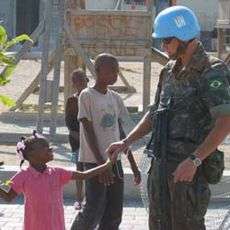Defence Force of Haiti
The Defence Force of Haiti (French: Force de Défense d'Haïti) was the envisaged name of the planned, reconstituted armed forces of the Republic of Haiti. Haiti had not had a regular armed forces since 1995; a process to reestablish them was initiated in 2011 and culminated in their remobilization in 2017.
| Armed Forces of Haiti | |
|---|---|
| Forces Armées d’Haïti | |
 Coat of arms of Haiti | |
| Motto | Protect and Defend Protéger et Défendre |
| Founded | 2011 |
| Current form | 2017 |
| Service branches | Haitian Army Haitian Navy Haitian Air Force Haitian Coast Guard |
| Headquarters | Port au Prince |
| Leadership | |
| President of Haiti | Jovenel Moïse |
| Commander-in-Chief | Lt. Gen Jodel Lesage |
| Minister of Defense | Hervé Denis |
| Industry | |
| Foreign suppliers | |
| Related articles | |
| History | Military history of Haiti |
| Ranks | Military ranks of Haiti |
History
Due to decades of coups and counter-coups, the regular Haitian Army, Navy, and Air Force were abolished in 1995. The formal disbandment of the military, however, did not end its involvement in national life. In 2004 a paramilitary force of former Haitian soldiers, backed by the United States and France, deposed the government of Jean Bertrand Aristide.[1] Several years later, a group of former members of the Haitian military began the private, voluntary training of young men in field-craft and military tactics as a demonstration of the potential of a new armed force.[2] By 2012 these recruits numbered between 3,000 and 15,000.[3] That same year, Haitian veterans forcibly occupied several decommissioned army posts to press the government to reestablish the military, and later interrupted a meeting of the Chamber of Deputies to demand the approval of Laurent Lamothe's nomination as prime minister, an action which UN officials denounced as an "unacceptable act of intimidation."[3][4]

In 2011, following his election as president of Haiti, Michel Martelly promised to reestablish the military. The move was generally seen as a popular response to widespread public dissatisfaction with the ongoing United Nations Stabilisation Mission in Haiti;the unsanitary and poor practices of Nepalese UN soldiers were cause to a cholera epidemic while Uruguayan and Pakistani UN troops were allegedly complicit in the rape of Haitian boys.[5][6] "[7] Carl Alexandre, deputy United Nations envoy overseeing police and judicial reform in Haiti, meanwhile blamed "proliferating armed forces" by the Haitian government as a reason for increased bandit attacks in the countryside, and called on the Haitian National Police to be affirmed as the country's only security apparatus.[8]
Critics of the planned force note that Haiti does not have any enemies, however, proponents point to the need to fill a "security vacuum" they say will emerge following the departure of the UN Stabilisation Mission in Haiti, and that a military is needed to fulfill missions such as securing the nation's porous border with the Dominican Republic, responding to natural disasters, and restoring "national pride".[9]
Training and recruitment
An initial plan envisaged a military force of 3,500 personnel operational by 2014.[10] Aided by Ecuador, Haiti had managed to raise and train a force of 41 personnel by September 2013, though this nucleus unit of sappers, officially termed the "Corps of Engineers," was unarmed and mission focused on infrastructure construction.[11] The following January an additional contingent of 30 recruits left the country for training in Ecuador and, in November of that year, a further 40 recruits left for Ecuador to partake in the eight-month course.[12][13]
In July 2015 Martelly formally announced the new force would be called the Force de Défense d’Haïti (Defence Force of Haiti) and would be tasked with "control of our borders, our sea and air space and [preparing for] the departure of UN forces." According to Martelly, a stepped-up recruitment campaign was set to begin in October 2015.[14]
In October 2017, under the administration of Jovenel and Prime Minister Lafontant, President Moise who is allied with former President Martelly remobilized the Armed Forces. The Haitian National Police remains under a UN mandated mission that is called MINIJUSTH which is set to expire in 2019.
References
- Edmonds, Kevin. "Restoration of the Haitian Army: Martelly Keeps One Campaign Promise". nacla.org. NACLA. Retrieved 6 September 2015.
- "Would-be soldiers hope for revival of Haitian army". Lubbock Avalanche-Journal. 9 March 2011. Retrieved 6 September 2015.
- "Haiti's Paramilitary Threat". coha.org. Council on Hemispheric Affairs. Retrieved 6 September 2015.
- Daniel, Trenton (24 November 2012). "Haiti veterans in hiding renew vow to remobilize". San Diego Union-Tribune. Retrieved 6 September 2015.
- "Haiti's army Who needs them?". The Economist. 19 October 2013. Retrieved 6 September 2015.
- "Armed Forces". globalsecurity.org. Global Security. Retrieved 6 September 2015.
- Baptiste, Nathalie (11 March 2014). "Back to Dark Days in Haiti?". The Nation. Retrieved 6 September 2015.
- Charles, Jacqueline (15 October 2013). "Armed bandits testing Haiti's understaffed police forces". Miami Herald. Retrieved 6 September 2015.
- Trenton, Daniel (5 December 2011). "Nobel Laureate: Haiti pres's army plan an "error"". San Diego Union Tribune. Retrieved 6 September 2015.
- Delva, Joseph. "Haiti president lays out path to restore army". Reuters.
- "Haiti a step closer to having army again". USA Today. 16 September 2013. Retrieved 6 September 2015.
- Delva, Joseph (14 February 2014). "Haiti new military force now effective, launches operations". Haitian Caribbean News Network. Retrieved 6 September 2015.
- "Haiti – Army : Graduation of 40 Haitian soldiers trained in engineering and combat". Haiti Libre. Retrieved 6 September 2015.
- "The country is ready to reform its army". Haiti Libre. 22 July 2015. Retrieved 6 September 2015.